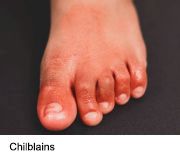SARS-CoV-2 undetected by PCR on nasopharyngeal swabs and in biopsy samples of skin in 31 patients
TUESDAY, July 7, 2020 (HealthDay News) — In a case series of 31 patients, published online June 25 in JAMA Dermatology, chilblains did not appear to be directly associated with COVID-19.
Anne Herman, M.D., from the Université Catholique de Louvain in Brussels, and colleagues examined whether chilblains are associated with COVID-19 in a monocentric case series conducted at a tertiary care hospital. Thirty-one patients who had recently developed chilblains were included.
The researchers found that the patients were generally in good health and most were teenagers or young adults. The diagnosis of chilblains was confirmed in histopathologic analyses of skin biopsy specimens, and occasional lymphocytic or microthrombotic phenomena were observed. In seven patients, an immunofluorescence analysis showed vasculitis of small-diameter vessels. Severe acute respiratory syndrome coronavirus 2 (SARS-CoV-2) remained undetected by real-time reverse transcriptase polymerase chain reaction on nasopharyngeal swabs and in biopsy samples of skin lesions for all patients. In all patients, immunoglobulin M and immunoglobulin G antibody titers were negative for SARS-CoV-2. There were no significant abnormalities noted in blood test results indicative of systemic disease.
“We report several cases of chilblains occurring mainly in young people during the COVID-19 pandemic,” the authors write. “We hypothesize that these skin lesions may be caused by lifestyle changes brought on by containment and lockdown measures. Dermatologic lesions, even if increasingly observed during the current pandemic, should be carefully interpreted.”
Copyright © 2020 HealthDay. All rights reserved.








